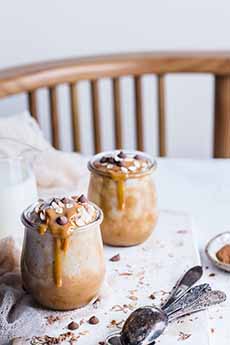Butterscotch Pudding Recipes For National Butterscotch Pudding Day
|
|
September 19th is National Butterscotch Pudding Day. The butterscotch pudding recipes are below, but there would be no such recipes if it were not for butterscotch candy. Butterscotch was invented in England, as a hard candy. It is often credited to Samuel Parkinson, a confectioner in Doncaster, a town in Yorkshire, in Northern England. Parkinson began making the candy in 1817, and the brand still exists. Other local confectioners followed suit, and the town became famous for its butterscotch candy, known as Doncaster butterscotch. An 1848 issue of the “Liverpool Mercury” gave the recipe for “Doncaster butterscotch” as “one pound of butter, one pound of sugar and a quarter of a pound of treacle*, boiled together” [source]. We don’t know if the Liverpool Mercury meant brown sugar, but the signature flavor of butterscotch comes from brown sugar, not white sugar. (Look at the ingredients of today’s butterscotch and you’ll also find corn syrup†, vanilla or other flavors, and water.) To make butterscotch sauce, the butter and brown sugar are mixed with cream. How about some butterscotch sauce with your butterscotch pudding? Check out photo #1. > The difference between butterscotch, caramel and toffee. The original English puddings were savory, boiled puddings containing meat. By the latter half of the 18th century, traditional English puddings no longer included meat; they were still boiled or steamed, even baked. The finished product was cake-like (like plum pudding). Our creamy American puddings, though very different from what the British call pudding, descend from this tradition of steaming sweet ingredients. Here’s more history of pudding. American colonists continued the English tradition of baking sweet puddings. The earliest print reference, for chocolate pudding, is 1730. Chocolate custard, a thick creamy cousin, dates to the 19th century. These sweets were enjoyed by wealthy people [source]. In 1837 in Birmingham, England, chemist Alfred Bird invented custard powder for his wife who couldn’t eat eggs. He began marketing it across the U.K. in 1844. Not long afterward the product arrived in the U.S., and Americans began to use it as an alternative to egg thickeners. It wasn’t long before American cooks started to use custard powder and other cornstarch derivatives as thickeners for custard-type desserts. > The different types of custard. Creamy American puddings evolved from these. We don’t know when butterscotch pudding joined the American pudding lineup (most likely vanilla and chocolate were first). It will take someone with access to cookbooks of the 19th century to do some research. From whence came the word “butterscotch?” No one knows for certain, but here are three explanations: TIP: When you make butterscotch pudding, you can add a teaspoon of bourbon or Scotch for a sophisticated undertone.
|
|
|
________________ *Treacle is another term for golden syrup, made from partly refined sugar; molasses. Golden syrup is light treacle, a thick, amber-colored syrup. There is also dark treacle, with a stronger flavor. In the U.S. it is known as blackstrap molasses. †The difference between corn syrup and golden syrup: While both are similar in color, they are very different products. Corn syrup is made from corn(starch), whereas golden syrup is made from sugar. Corn syrup has a very mild flavor, whereas golden syrup has a more pronounced buttery caramel flavor. Corn syrup is an invert sugar, which means that it prevents sugar crystals from forming. The process to make corn syrup from cornstarch was invented in 1811 by a German chemist, Gottlieb Kirchhoff. Invert sugar syrup, also called invert syrup and invert sugar, is a mixture of two simple sugars (glucose and fructose) that is made by heating sucrose with water. |
||



